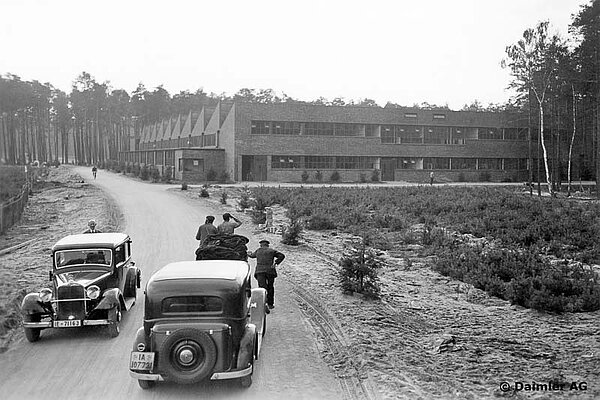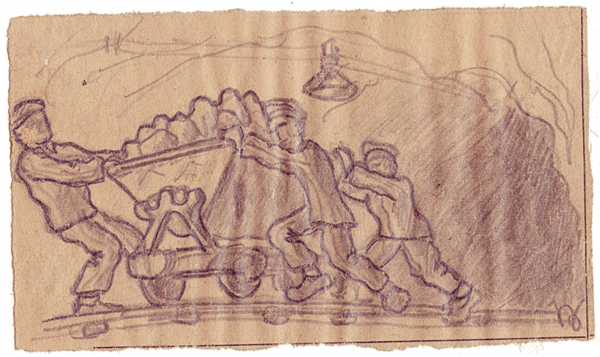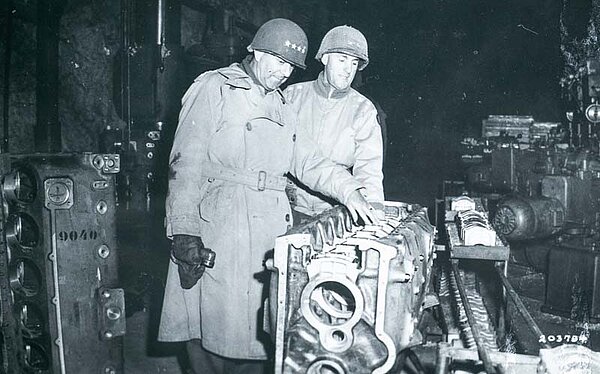The "Goldfish" Company
History of an Underground Armament Factory
Causes and Interests

After Hitler seized power in 1933, the rearmament of Germany began. The dictator plannned a new war, a war that would make everyone forget the disgraceful defeat of 1918.
The Nazi leaders and the military were depending on a strong air force. This opened new opportunities for technology companies like Daimler-Benz. That is why the Daimler-Benz Motorengesellscaft opened the airplane engine factory in Genshagen, south of Berlin, as part of the war preparation of the German Reich. At the beginning of 1941, in this ultra modern armamemt factory, the twelve cylinder motors DB 603 and 605 were produced - top products of arms technology.
The war that had begun in 1939 initially brought quick victories. In the winter of 1942/43 however, the fortunes of the war began to turn, and in 1944 the allies won sovereignty over German airspace. Bomb attacks on the armaments factories increased. The factory in Genshagen was first hit at the beginning of March 1944, during the wave of attacks known as the "Big Week".
Now more than ever, it was important for Nazi-Germany to produce a large number of airplanes for air combat. In order to accomplish this, they put together s special military staff ("Jägerstab") on March 1, 1944. It created an interface between the air force, the armament ministry, the SS and industrial companies. They were to organize the "distribution" of production to the various locations, as well as the relocation to underground "bombproof" spaces.
As a result of the war, there was a great shortage of workers. The relocation program could only be realized if the SS deployed as many "prisoners in protective custody as needed to work at the construction sites and in manufacturing."
The "Friede" and "Ernst" gypsum mines located on the banks of the Neckar near Obrigheim, were chosen as the new locations for the airplane engine production of Daimler-Benz´s Genhagen plant. The mine was large enough, and easy to convert and expand. Furthermore, it was conveniently situated on the train line that existed at the time - Heidelberg-Mosbach via Sinsheim-Aglasterhausen-Obrigheim and on the waterway of the Neckar.
The project was given the SS-name "A8"/"A8b", later the code names "Goldfish" and "Brasse" (bream). In order to accomodate the concentration camp prisoners, a satellite camp of the Natzweiler concentration camp was set up at the Neckarelz school. Later on, more concentration camps were set up in the area.
Construction Work: The Suffering of the Concentration Camp Prisoners

In a mere seven weeks, the gypsum mine was to be turned into an underground factory building. Although this would soon prove to be an impossibility - essentially construction would continue as long as "Goldfish" existed despite the constant deadline pressure. The construction management was shared by the SS and Daimler-Benz, and the construction volume bore the cost of 3,8 million Reichmarks.
As early as mid March 1944, the SS transported the first 500 prisoners from Dachau. They were to set up the construction site, and were to begin with the "excavation and levelling work", because the floor of the gypsum mine had to be filled with concrete before the machines were to be placed. It would soon become evident that their labour would not suffice. New prisoners were requested, so that the deadlines could be more or less adhered to: "Goldfish" was to deliver airplane engines beginning in the summer of 1944.
The construction company Hochtief anticipated the need for 470 tons of construction iron and 270 tons of machine iron. It was planned that 440 solid cubic meters of lumber and 870 cubic meters of cut timber would be processed. In total, 270,000 bricks and 3,200 tons of cement were to be processed. This took place sadly, and literally on the backs of the concentration camp prisoners. They had to set up the complete infrastructure of the factory while constantly being beaten and threatened - all the while being insufficiently nourished and inadequately clothed-and working both the day and night shifts.
Further facilities were built outside the gallery. A material storage, a heating system for the gallery ("Kesselhaus"), as well as a transshipment hall for the completed engines.
In September and November 1944, part of the gallery´s roof collapsed and buried both people and machines. Other workplace accidents occurred frequently, especially for the concentration camp prisoners who had practically no safety measures.
Engine Production
At the beginning of May 1944, the "Melzer Office" was set up in Mosbach by the SS and the planning engineers from Daimler-Benz, in order to organize the transfer of both machines and people from Genshagen to the gallery. The move was to have taken place by the middle of June: All 2,000 machines were to be set up in the underground workshops so as to resemble the same system as in the Genshagen plant. The first 21 machines from Genshagen actually arrived at the Neckarelz train station on June 26, 1944. At the same time transports from Genshagen carrying people arrived, as they, too were to be transferred just like the machines. In total, almost 5,000 "loyal followers" (forced labourers and free workers) poured into the region. "Goldfish" engaged a total of 10,000 people: 5,000 concentration camp prisoners and the same number of additional workers. However, everything still took much longer than planned.
When the transfer was finally completed in early fall 1944, the production began. It wasn´t until the beginning of October 1944, that the production technology in "Goldfish" was at the point that the first engines to be completely produced underground could be delivered. Every month, up to 500 new engines were to be built, and about 350 in the reassembly-department were to be repaired and refurbished. This nominal output could however never be produced; The SS feared a catastrophical decline in production for the winter.
In the fall of 1944, the retrodisplacement of machines from the "Rochen" plant in Dubnica/Slovakia was pushed through by Daimler-Benz, as well as the partial relocation of the Sindelfingen plant. More and more machines that would never be used for the immediate production of engines, were stored in the "Goldfish" and especially in the "Brasse" galleries. Thereby, Daimler-Benz was already planning for the postwar period.
The End of "Goldfish"

In February 1945, the constant bomb attacks, the unfavorable war situation as well as supply problems all brought production to a standstill. Beginning mid March, all the workers were "released".
Hitler´s order that all production plants be destroyed was averted in the case of "Goldfish". Solely, the railway bridge over the Neckar was blown up. On April 2, 1945, American troops occupied the Neckar valley and immediately investigated the underground factory.
After the war, the seized gypsum mine was returned to the Portland Cement company. Today, their successor, Heidelberg Cement still mines gypsum from the hills on the banks of the Neckar.

